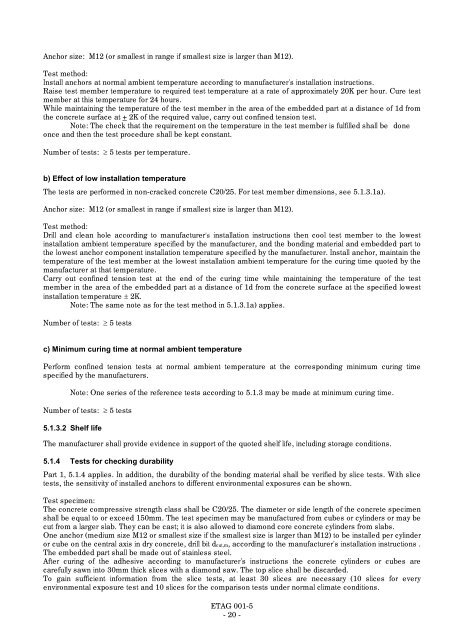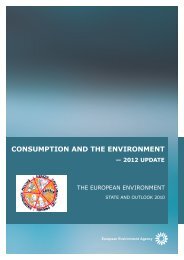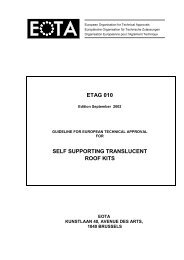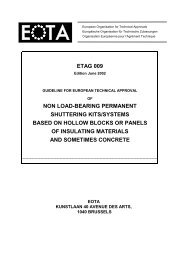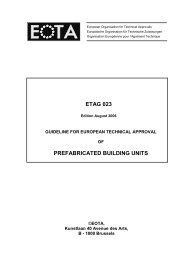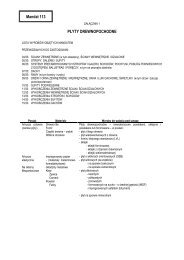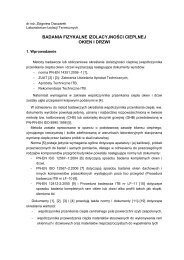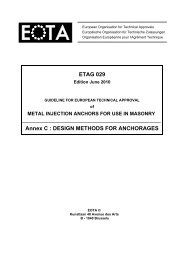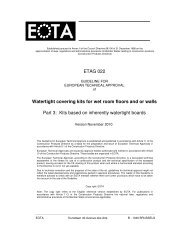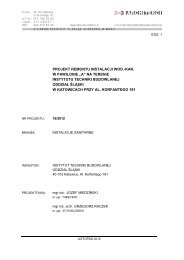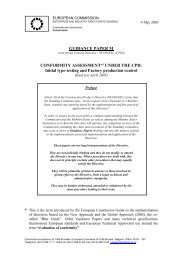ETAG 001
ETAG 001
ETAG 001
You also want an ePaper? Increase the reach of your titles
YUMPU automatically turns print PDFs into web optimized ePapers that Google loves.
Anchor size: M12 (or smallest in range if smallest size is larger than M12).Test method:Install anchors at normal ambient temperature according to manufacturer's installation instructions.Raise test member temperature to required test temperature at a rate of approximately 20K per hour. Cure testmember at this temperature for 24 hours.While maintaining the temperature of the test member in the area of the embedded part at a distance of 1d fromthe concrete surface at + 2K of the required value, carry out confined tension test.Note: The check that the requirement on the temperature in the test member is fulfilled shall be doneonce and then the test procedure shall be kept constant.Number of tests: 5 tests per temperature.b) Effect of low installation temperatureThe tests are performed in non-cracked concrete C20/25. For test member dimensions, see 5.1.3.1a).Anchor size: M12 (or smallest in range if smallest size is larger than M12).Test method:Drill and clean hole according to manufacturer's installation instructions then cool test member to the lowestinstallation ambient temperature specified by the manufacturer, and the bonding material and embedded part tothe lowest anchor component installation temperature specified by the manufacturer. Install anchor, maintain thetemperature of the test member at the lowest installation ambient temperature for the curing time quoted by themanufacturer at that temperature.Carry out confined tension test at the end of the curing time while maintaining the temperature of the testmember in the area of the embedded part at a distance of 1d from the concrete surface at the specified lowestinstallation temperature 2K.Note: The same note as for the test method in 5.1.3.1a) applies.Number of tests: 5 testsc) Minimum curing time at normal ambient temperaturePerform confined tension tests at normal ambient temperature at the corresponding minimum curing timespecified by the manufacturers.Note: One series of the reference tests according to 5.1.3 may be made at minimum curing time.Number of tests: 5 tests5.1.3.2 Shelf lifeThe manufacturer shall provide evidence in support of the quoted shelf life, including storage conditions.5.1.4 Tests for checking durabilityPart 1, 5.1.4 applies. In addition, the durability of the bonding material shall be verified by slice tests. With slicetests, the sensitivity of installed anchors to different environmental exposures can be shown.Test specimen:The concrete compressive strength class shall be C20/25. The diameter or side length of the concrete specimenshall be equal to or exceed 150mm. The test specimen may be manufactured from cubes or cylinders or may becut from a larger slab. They can be cast; it is also allowed to diamond core concrete cylinders from slabs.One anchor (medium size M12 or smallest size if the smallest size is larger than M12) to be installed per cylinderor cube on the central axis in dry concrete, drill bit dcut,m, according to the manufacturer's installation instructions .The embedded part shall be made out of stainless steel.After curing of the adhesive according to manufacturer's instructions the concrete cylinders or cubes arecarefully sawn into 30mm thick slices with a diamond saw. The top slice shall be discarded.To gain sufficient information from the slice tests, at least 30 slices are necessary (10 slices for everyenvironmental exposure test and 10 slices for the comparison tests under normal climate conditions.<strong>ETAG</strong> <strong>001</strong>-5- 20 -


